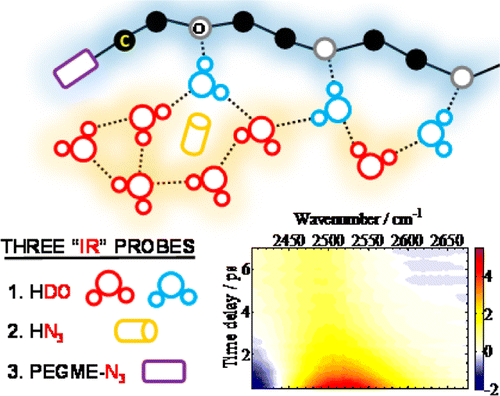Polyethylene glycol (PEG) is a unique polymer material with enormous applicability in many industrial and scientific fields. Here, its use as macromolecular crowder to mimic the cellular environment in vitro is the focus of the present study. We show that femtosecond mid-IR pump–probe spectroscopy using three different IR probes, HDO, HN3, and azido-derivatized crowder, provides complete and stereoscopic information on water structure and dynamics in the cytoplasm-like macromolecular crowding environment. Our experimental results suggest two distinct subpopulations of water molecules: those that interact with other water molecules and those that are part of a hydration shell of crowder on its surface. Interestingly, water dynamics even in highly crowded environment remains bulk-like in spite of significant perturbation to the tetrahedral H-bonding network of water molecules. That is possible because of the formation of water aggregates (pools) even in water-deficient PEGDME-water solutions. In such a crowded environment, the conformationally accessible phase space of the macromolecular crowder is reduced, similar to biopolymers in highly crowded cytoplasm. Nonetheless, the hydration water on the surface of crowders slows down considerably with increased crowding. Most importantly, we do not observe any coalescing of surface hydration water (of the crowder) with bulk-like water to generate collective hydration dynamics at any crowder concentration, contrary to recent reports. We anticipate that the present triple-IR-probe approach is of exceptional use in studying how conformational states of crowders correlate with structural and dynamical changes of water, which is critical in understanding their key roles in biological and industrial applications.

http://pubs.acs.org/doi/abs/10.1021/jacs.6b10164



















